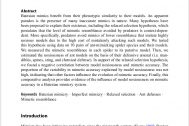Content
Batesian mimics benefit from their phenotypic similarity to their models. An apparent paradox is the presence of many inaccurate mimics in nature. Many hypotheses have been proposed to explain their existence, including the relaxed selection hypothesis, which postulates that the level of mimetic resemblance avoided by predators is context-dependent. More specifically, predators avoid mimics of lower resemblance that imitate highly noxious models due to the high cost of mistakenly attacking such models. We tested this hypothesis using data on 93 pairs of ant-mimicking spider species and their models. We measured the mimetic resemblance in each spider to its putative model. Then, we estimated the noxiousness of ant models on the basis of their defensive arsenal (i.e. mandibles, spines, sting, and chemical defense). In support of the relaxed selection hypothesis, we found a negative correlation between model noxiousness and mimetic accuracy. The proportion of the variability in mimetic accuracy explained by model noxiousness was not high, indicating that other factors influence the evolution of mimetic accuracy. Finally, this comparative analysis provides evidence of the influence of model noxiousness on mimetic accuracy in a Batesian mimicry system.



